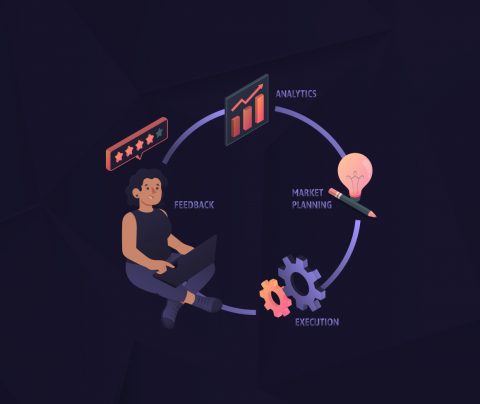When I first got into affiliate marketing, I thought I needed a website, a domain, and maybe even a sleek landing page before I could make a cent. That mindset delayed me for months. The truth is, you don’t need a website to start earning. What you need is attention, consistency, and a way to understand what’s working.
The main challenge isn’t technical setup – it’s structure. A website naturally gives you control: analytics, pages, and tracking. Without one, everything feels scattered. You post links across social media and hope something sticks. But without proper data, you don’t really know where the sales come from. That’s what burns out most beginners.
This problem is exactly what led us to build Hyperone – a platform designed to bring clarity to traffic management and affiliate analytics, even for those who don’t use a website. We wanted to remove technical friction and help people focus on growth instead of setup.
The real problem: no website, no structure
Affiliate beginners often underestimate how chaotic things get once multiple links start floating around. You post one in your TikTok bio, another in Telegram, a third in YouTube descriptions. Soon, you have traffic, but zero visibility. Which post performed best? Which campaign brought conversions? You don’t know.
That’s where structured tracking matters. Hyperone wasn’t built to “replace” websites; it was built to give structure to those who operate without them. We designed it to track traffic sources, detect fraud, and automate link routing – all without the need for coding or hosting. The idea was simple: if you can measure, you can improve.
We saw too many marketers wasting hours on manual spreadsheets and unreliable link shorteners. So we built a transparent system where you see exactly how each channel performs. That’s our philosophy – clarity over complexity.
TikTok: short videos, big conversions
TikTok changed the game. It doesn’t care who you are or how many followers you have. If your content is engaging, it will be seen. That’s what makes it one of the most powerful platforms for affiliate beginners.
I’d start with short, value-packed videos that grab attention immediately. Quick transformations, honest reactions, or app demos work best. People scroll fast, so your hook has to land in the first two seconds.
But TikTok’s biggest limitation is link placement. Most users can only place one link in their bio. That’s where organized tracking becomes crucial. When we built Hyperone, we wanted users to be able to create unique links for every campaign. Whether you post one offer or ten, you’ll always know which video brought the sale.
YouTube: the slow burn that keeps paying
YouTube is where affiliate marketing gets long-term. Videos here don’t disappear overnight – they build momentum. But that also means it takes time.
If I were starting today, I’d go for tutorial-style content. People search for solutions, not brands. “Best tool for freelancers” or “how to earn passive income with X app” will outperform generic reviews every time.
But again, the problem is tracking. YouTube analytics show you views, not conversions. That’s why we made sure Hyperone can assign a unique ID to every link in your descriptions. You can literally see which video or timestamp brought conversions. That’s the difference between guessing and growing.
Pinterest: the quiet engine of evergreen traffic
Pinterest is the long game. It’s not loud or flashy – but it works. A well-designed pin can bring clicks for months. It’s visual SEO, not viral marketing.
If you’re promoting lifestyle or product-based offers, Pinterest is a perfect starting point. You don’t need fancy graphics; simple designs with keywords perform well. The only real downside is delayed gratification. Pins take time to rank.
That’s exactly why we wanted Hyperone to show long-tail performance metrics. Many analytics tools only focus on instant conversions. We wanted users to see value over time – how a single pin from two months ago still generates sales today. For us, transparency isn’t a feature – it’s the foundation.
Telegram: building a loyal micro-community
Telegram feels different from other platforms. It’s intimate. People subscribe because they trust you. It’s where genuine communities form, and affiliate links can perform exceptionally well if you build real connection first.
When I managed my first Telegram channel, I focused on value before offers. Daily insights, quick recommendations, even polls – all that builds engagement. Then, once trust is established, affiliate links don’t feel like ads.
The challenge is organization. If you post in multiple channels or groups, keeping track of conversions becomes a nightmare. That’s why we built automation directly into Hyperone. You can create and label each link, even if you share it across multiple chats. The system handles redirection, tracking, and reporting. You stay focused on your content, not spreadsheets.
Instagram and reels: where lifestyle sells
Instagram is less about pitching and more about showing. You sell through personality. When people feel they know you, they trust your recommendations.
Reels are perfect for quick, emotional stories. You don’t need polished ads – raw, human moments perform better. But again, the tracking challenge remains. Instagram stories, bios, and DMs all generate traffic that’s hard to measure.
When designing Hyperone’s dashboard, we focused on solving that fragmentation. You can track every link, no matter where it lives. The interface shows which platform, post, or ad delivered results. It’s not about overwhelming users with charts – it’s about giving clarity without effort.
Tracking without a website
Here’s the core problem every beginner faces: they have traffic, but no clarity. Without tracking, affiliate marketing becomes guesswork. You think something works because it “feels” right, but your numbers might tell a different story.
That’s the entire reason we created Hyperone. We didn’t want affiliates, media buyers, or resellers to lose profit because of missing data. Our platform automates tracking, routes traffic intelligently, and detects fraudulent clicks in real time.
We wanted to make it possible for anyone, whether you’re running campaigns from TikTok or Telegram, to have the same analytical power as someone managing a website with advanced tracking tools. No setup fees, no locked features, no paywalls around analytics. Just transparency.
That’s what makes Hyperone different. It’s not another generic tracker. It’s a system built by people who understand the pain of manual affiliate management. We’ve lived that frustration ourselves.
When to scale up
Eventually, you’ll want a website. It gives you ownership, stability, and full control of your audience. But before that, you need to master the basics, creating attention, understanding your data, and building relationships.
Once you reach that point, having clear analytics from your early campaigns will make scaling effortless. You’ll know exactly which audiences to target and which offers convert best. Hyperone was built with that transition in mind. Whether you manage one campaign or hundreds, it grows with you.
Final thoughts
Affiliate marketing without a website works. It’s fast, messy, and often confusing, but it’s real. You can start with your phone and a few ideas. What separates successful affiliates from the rest isn’t luck – it’s clarity. Knowing what drives results and adjusting fast.
That’s the mindset we had when developing Hyperone. We didn’t want to sell hype. We wanted to build something that gives control back to the user. Something that makes affiliate work transparent, efficient, and future-proof.
If you’re just starting, focus on creating valuable content and learning how traffic behaves. And when you’re ready to manage it all in one place, you’ll already understand why we built Hyperone the way we did to make this whole journey simpler, smarter, and genuinely yours.













